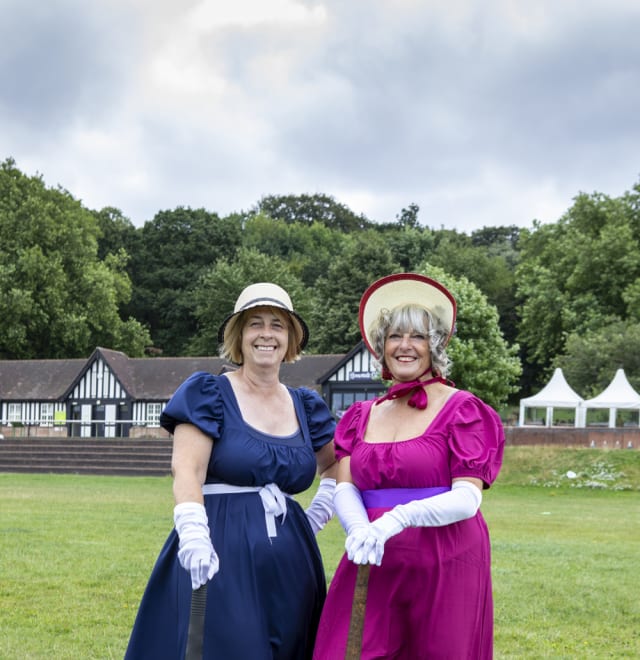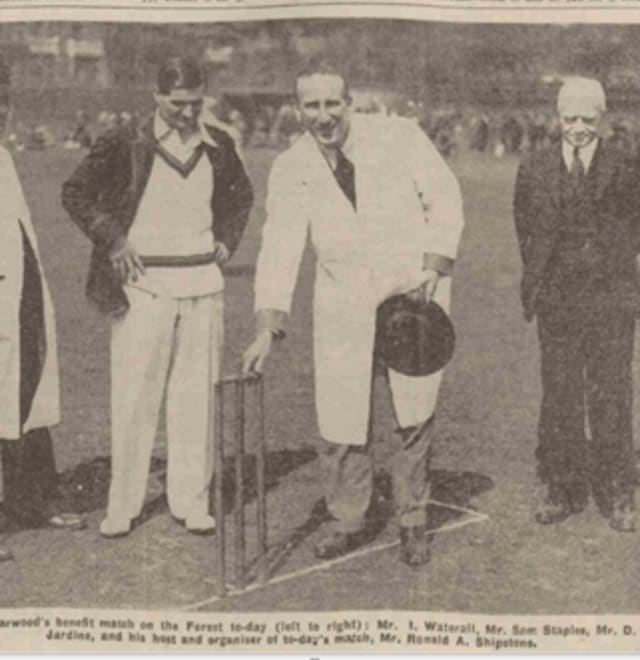‘A Walk in the Park’ marks 250 Years of Cricket in Nottingham
On the morning of 26 August, some cricket players, in a motley collection of kit, arrived on The Forest recreation ground and decided where to pitch the wickets for a game….
That sentence might have been written 250 years ago, or today.
In August 1771, the Gentlemen of Nottingham met the Gentlemen of Sheffield in a three-innings game of cricket that is the first recorded match in the county. That it is known at all is down to one report, in a letter to the Nottingham Journal, of the acrimonious ending when the Sheffield players ‘resolved not to play again’ after disputing an umpire’s decision.
Not, perhaps, the most glorious of starts for the long and illustrious history of cricket in Nottingham and an association with playing on The Forest that continues in the 21st Century.
To mark the 250th Anniversary, on 26 August 2021, a group of Volunteers and staff from Trent Bridge, led by regulars from the Rushcliffe Walking Cricket group, played a friendly ‘Walking Cricket’ competition.
Among the players was Enid Bakewell MBE, Nottingham’s former England all-rounder and recent inductee to the ICC Hall of Fame, who remembered playing rounders on The Forest but not cricket. Two other women – regular Trent Bridge Match Day Volunteers Christine and Arlene – got into the spirit of the day, playing in period costume.
photo: courtesy @anne_tate_photography
That was quite suitable as Walking Cricket is a far more genteel game than that played in the 1770s, (there were no umpiring disputes or bets on the outcome this time) and it made for a relaxed and enjoyable occasion to mark not just the notional start of cricket in the County but also the long association of The Forest with sport, and cricket in particular.
Informal games still take place there in the summer months on artificial pitches that are (probably) an improvement on the unprepared grounds of 1771 and were used for the walking cricket games.
Cricket was played on The Forest – the home ground for Nottingham until Trent Bridge was laid out by William Clarke – in the 18th Century and throughout the next 250 years. Among the many great cricketers to play there was Bill Lockwood who, though born in Old Radford, found fame as an opening bowler for Surrey and England in the late 1800s and Learie Constantine, the first world star from the West Indies and later to be knighted; in 1969 as Baron Constantine, he was the first black man to sit in the House of Lords.
Not all the players found such renown as those two but over the years, more than 40 different Nottingham clubs have had their home on The Forest and many hundreds of cricketers will have had their formative experience of the game there. One such club is Ellerslie, which started playing on The Forest in 1922-23 as a staff team from the Ellerslie House hospital on Gregory Boulevard and was among the last to leave in 1980 when the pitches were deemed not up to standard (though almost certainly still better than in 1771!).
Having left The Forest for their new home at Trent Bridge, the County Club did not return for 101 years when, in 1936, more than 5,000 people turned up for a match played as part of Harold Larwood’s benefit season. A strong Notts XI met a team put together by Larwood’s team-mate Sam Staples with Harold’s Ashes-winning skipper (and fellow ‘villain’ of the Bodyline series) Douglas Jardine standing as one of the umpires.
The last game prior to this had been the first inter-county match to be played in Notts when Sussex were the visitors. The story of that game here
Games in the 18th Century would have been played on any open space within the Forest, where the main sporting entertainment, cricket apart, would have been the extensive horse racecourse, a four-mile stretch that staged many meetings, including the King’s Plate of 1770, won by the great stallion Eclipse, whose bloodline continues even into today’s thoroughbreds. Later the cricket was staged on the enclosure within the re-sited racecourse, which was the case for the 1835 match. The racecourse moved to its present Colwick location in 1892.
Mention of The Forest as a sporting venue would be incomplete without acknowledging that Nottingham Forest Football Club started their playing days there and were in part named for their first home venue. The football team emerged from a ‘shinny’ (a local version of shinty) team to become a major force in English soccer, though that came long after they have moved from The Forest in 1879.
In addition to horse racing, football and cricket, The Forest staged foot races – running and walking – and bare-knuckle prize-fighting, all backed by gambling and often under the sponsorship of wealthy businessmen and landowners.
In 1773, upwards of 15,000 people watched a 10-mile running race (2 x 5m laps) round the racecourse for which the price was £200 (more than £17,000 today), won by Mr Harrison of Staffordshire over Mr Granny of Belper.
The 'Walk in the Park' of 2021 was rather less energetic and ended not with a prize purse but some civilised tea and cakes.
August 2021